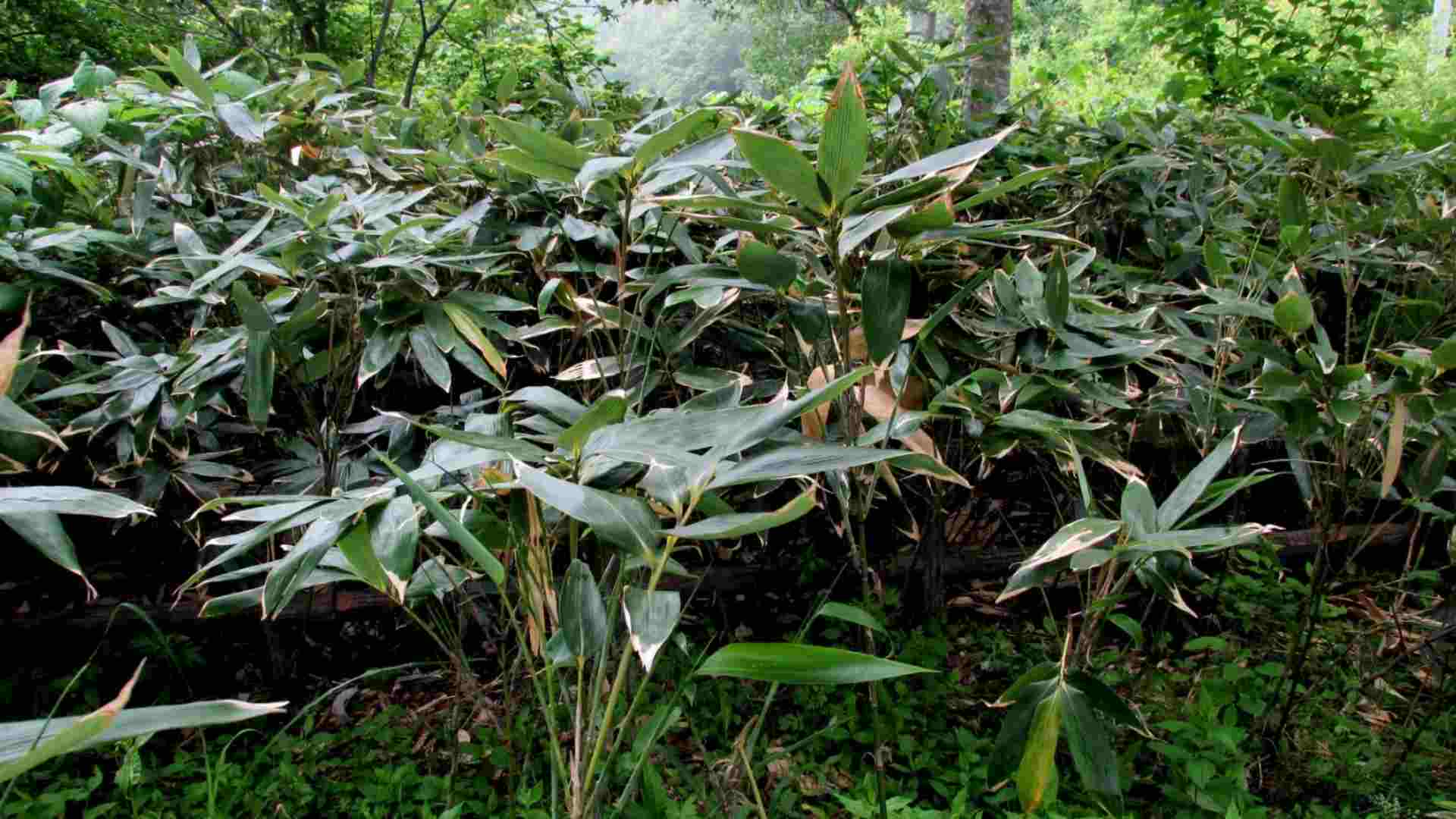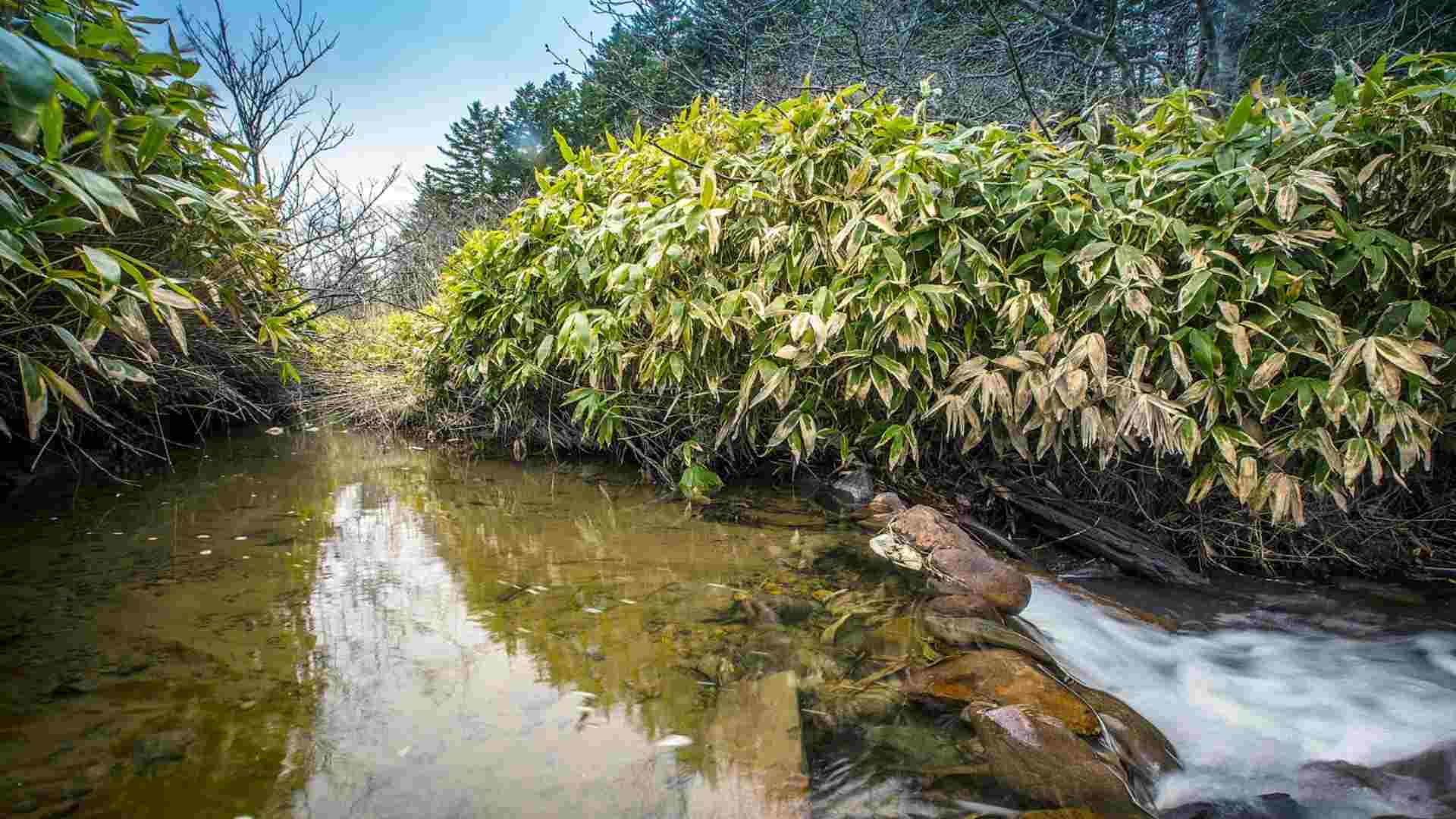Don’t look up. This is not one of those bamboo varieties that grows taller than your house. But if you’re trying to find it on a map, well then, you will have to look up. This botanical outlier is the northernmost naturally occurring bamboo known to science.
Sasa kurilensis is an exotic, Far Eastern species of dwarf bamboo endemic to the Kuril Islands north of Japan. Situated between 44 and 46 degrees north of the equator, the islands represent the northernmost native habitat of any bamboo species. These uninhabited islands, around the Sea of Okhotsk, are the subject of a territorial dispute between Japan and Russia.
This article — first published in June 2022 and most recently updated in September 2024 — is part of an ongoing series about different species and cultivars of bamboo. To learn more, check out some of these other detailed articles.
- BAMBOO SPECIES GUIDE
- A gallery of bamboo species
- Black Bamboo: Phyllostachys nigra and others
- Blue Bamboo: Species that stand out
- Buddha’s Belly Bamboo
- Chimonobambusa quadrangularis: Square Bamboo
- Golden Bamboo: Phyllostachys aurea and others
- Semiarundinaria Fastuosa: Temple Bamboo
- Tortoise Bamboo: Phyllostachys edulis ‘Heterocycla”
Characteristics of Sasa kurilensis
Like most other members of the genus Sasa, S. kurilensis is a small variety of bamboo native to northern Japan and eastern Russia. It sometimes goes by the Japanese name ‘Shima-shimofuri‘. In its native habitat, this plant grows in the forest understory, beneath the canopy of taller trees. According to these conditions, it prefers cooler settings with considerable shade.
Typically, S. kurilensis will grow about 5 to 10 feet tall, at the most. The culms are very slender, not more than a half-inch in diameter. Leaves are deep green, and fairly large, several inches long and 2 to 3 inches wide. The brightly colored, evergreen foliage makes for an attractive, modestly-sized ornamental plant.

Like all species of Sasa, this is a running bamboo. Despite its small stature, it can spread far and wide when provided with favorable growing conditions. This is a very cold-hardy species, able to survive temperatures down to 0º F or lower.
The geographic extremity of Sasa kurilensis
Northern exposure
Sasa kurilensis is recognized for being the northernmost species of bamboo and the only variety native to Russia. The species takes its name from the Kuril Islands, which extend to the north above Japan and into Russia.

This bamboo is especially widespread on Kunashir, the southernmost island of the Kuril archipelago. At around 45º north of the equator, the latitude here is comparable to Toronto, Canada, and Green Bay, Wisconsin.
You can also find Sasa kurilensis growing in Korea and on the Russian Island of Sakhalin.
Disputed territory
Being endemic to Kunashir and the Kuril Islands places Sasa kurilensis at the center of a geopolitical controversy. At the end of World War II, in 1945, the Soviet Union assumed control of Kunashir and three other islands. But Japan still claims possession of these islands, refusing to recognize Russia’s dominion.
In Japan, they refer to this as the Northern Territories Dispute. But in Russia, the hostile annexation of a foreign territory is more like business as usual.
Bamboo to the extreme
As long as we’re examining Sasa kurilensis, which we have established as the northernmost species of bamboo, let’s also consider some other extreme varieties.
How about the southernmost species of bamboo?
The Genus Chusquea boasts the unusual distinction of having the widest natural distribution of any bamboo. In terms of latitude, you can find these neotropical wonders, with solid stems, growing from 24º North in Sonora, Mexico, all the way down to 47° in southern Chile. It’s not clear which particular species are found at the southern extremities, but it could be Chusquea valdiviensis or Chusquea andina.
And what about the highest bamboo, in terms of altitude?
There are many mountain bamboo varieties that grow at elevations of a couple thousand feet above sea level, some even up to 10,000 feet and beyond. According to the Bhutan Ministry of Agriculture, Himalayacalamus falconeri can grow as high as 2,400 meters, or 7,800 feet.
Chusquea andina, native to the mountains of Chile and Argentina, is one the hardiest and most cold-hardy bamboos of South America growing at extreme altitudes in the high Andes. But those at the highest elevations exceeding 10,000 feet are more likely to be found in warmer climes near the equator. Chusquea tesselata, for example, scales the cloudy peaks of Colombia and Ecuador.
And the biggest?
If you’re looking for the largest bamboo species of all, that’s Dendrocalamus sinicus. Naturally occurring only in a small area of southern China and northern Laos, this monster has been known to reach 150 feet in height, with culms more than a foot in diameter.
Expand your horizons
I hope you found this story of an especially exotic bamboo species both interesting and educational. For more strange tales of bamboo and all its exceptional circumstances, take a look at some of the following articles.
- Hiroshima Bamboo: Atomic survivor
- Triple Hybrid Bamboo
- An Asian insect sparks a bamboo boom in Florida
- Rare and unusual bamboo species
FEATURED IMAGE: Sasa kurilensis ‘Shimofuri’ grows well in the cool climes of London, England. Photo by Fred Hornaday.

























